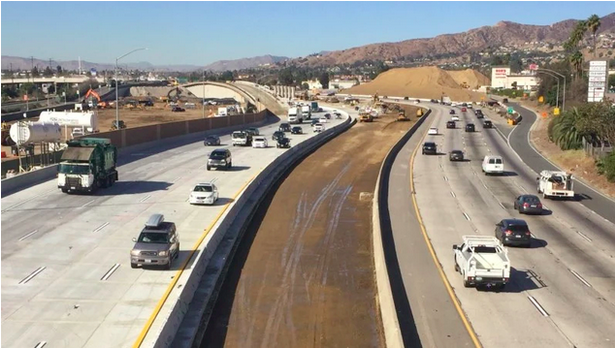Note: this piece originally appeared at NRDC
Late last month, the California Strategic Growth Council (SGC) released a bracing assessment detailing just how much further the state needs to go to ensure that its transportation infrastructure investments are helping the state cut carbon pollution. Core to this assessment is the finding that the state’s transportation spending is often working at cross purposes with its climate goals.
The report, required by Assembly Bill 285 (Friedman, 2019) and prepared by University of California Institute of Transportation Studies (UC ITS) researchers, notes that transportation accounts for over half of California’s greenhouse gas (GHG) emissions, so meeting the state’s climate goals requires making big changes in the transportation sector.
The report emphasizes that California needs a strategy for decarbonizing transportation that includes both rapid vehicle electrification, as well as transportation investments that help Californians get around more easily on rail, bus, bike, foot and in shared electric vehicles. Our state government must pursue both at the same time in order to cut emissions at the speed needed to reach the climate goals our state has committed to and reaffirmed many times.
So, what should be done?
The SGC report says the state must reverse the “historic emphasis on prioritizing driving over other modes” that has made it necessary to own a car (and bear the high cost of car ownership) in order to access the best housing, employment, social and educational opportunities the state has to offer.
While California has made much progress in funding sustainable transportation, the report notes that “too many…investments fail to move towards—and often still move away from” the vision of a sustainable transportation system.
The state still prioritizes funding for wider and faster roads, making it unsafe and unappealing to walk, bike and take transit in many places. In fact, the report notes that climate and equity-focused programs account for only two percent of the state’s transportation spending.
The state continues down this path despite decades of evidence—and official Caltrans policy—that widening highways doesn’t fix congestion in cities, but does increase driving and emissions. In other words, the report notes, “there is a gap between the vision for a more climate friendly and equitable transportation system and actions and infrastructure decisions” made by the state. Indeed, that’s an understatement!
How to close the gap?
The answer is at the same time simple to describe and hard to execute. Governor Gavin Newsom took an important step by signing Executive Order N-19-19 to accelerate climate action on transportation. Importantly, it said “the State Transportation Agency shall leverage the more than $5 billion in annual state transportation spending for construction, operations, and maintenance to help reverse the trend of increased fuel consumption and reduce greenhouse gas emissions associated with the transportation sector.”
That led the California State Transportation Agency (CalSTA) to develop the California Action Plan for Transportation Infrastructure (CAPTI) in July 2021. CAPTI directly targets reducing greenhouse gas emissions in transportation in its framework while also addressing the “need to prepare and adapt” the transportation system to the effects of climate change.
What does CAPTI say?
CAPTI takes a “fix-it-first” approach that’s consistent with the goals of the transformative Road Repair and Accountability Act of 2017 (SB 1). By emphasizing the maintenance, and not expansion, of existing road infrastructure, CAPTI calls for funds in existing programs to be used “where feasible” on investments in “new clean transportation options in urban, suburban, and rural settings for all Californians.” Specifically, CAPTI’s investment framework includes:
- building an integrated rail and transit statewide network
- creating networks of safe and accessible bicycle and pedestrian infrastructure, especially in low-income and disadvantaged areas
- increasing zero-emission vehicle infrastructure
- and promoting projects that do not significantly increase passenger vehicle travel
CAPTI points the way for better matching state transportation funding to state climate goals. That means we should stop spending billions on freeways that don’t fix congestion and that keep digging our carbon pollution hole deeper.
What’s next?
The AB 285 Assessment Report makes clear that the state needs to do a better job of putting its money where its mouth is in transportation funding. The state’s greenhouse gas reduction goals need to be reflected in what kinds of projects it funds. Fortunately, CAPTI provides a plan for doing this, and state officials are working to update the rules that decide which transportation projects get funding and how.
NRDC and our partners are advocating for changes that reflect CAPTI plans and shift funding from counterproductive highway expansion and road widening to transit and active transportation projects that enhance Californians’ quality of life, improve safety, increase equity of access, and reduce GHG emissions.
Getting plans in place for these sound investments is critical because a large influx of transportation funding from the $1.2 trillion Infrastructure Investment and Jobs Act is coming to California soon, and includes $25.3 billion for highway programs. The good news is that State Departments of Transportation have a great amount of flexibility to spend those highway funds on road projects that benefit people who walk, bike and take transit. CAPTI comes just in time to make sure California maximizes the opportunity to build healthy, sustainable, and equitable mobility.
Californians can weigh in on some of these questions this spring.






